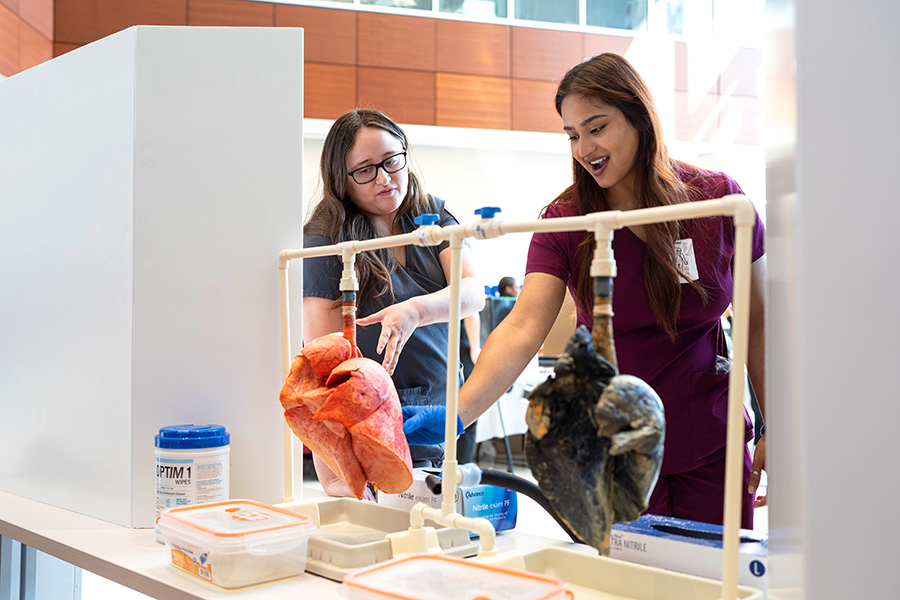Wilson School of Nursing awarded $2.7 million grant to train students for work in underserved areas
Two years ago, Midwestern State University’s Wilson School of Nursing received a $1.6 million Advanced Nursing Education Workforce (ANEW) grant from the Health Resources and Services Administration (HRSA). The grant supported the training of graduate students in the family nurse practitioners (FNP) program for work in rural and medically underserved areas, places where medical care is desperately needed.
Now, a $2.7 million competing continuation ANEW grant will support the second phase of the Medically Underserved Specialization for Advanced Nursing Graduate Students (MUSTANGS). The MUSTANGS II project will continue to prepare FNP students to gain primary care employment through academic and clinical training experiences with rural and underserved populations with a new focus on mental health medical management.
Assistant Professor of Nursing Catherine Pankonien, MUSTANGS II Project Director, said the addition of mental health training is important because of the effects that mental health disorders, including the opioid epidemic, have on rural health care. “Many times, small towns are not prepared to treat mental health issues. That’s not an easy condition to train for. And with the rising opioid crisis, we have to train students to deal with those issues.” Pankonien said.
The grant supports the education of FNP students by using academic-practice partners in the community, and by using telemedicine to communicate with faculty and health-care professionals in partner facilities. MSU Texas has four portable telemedicine units that students can take to rural clinics.
“It’s the wave of the future,” Pankonien said. “Checking skin issues, EKGs – all the information can be seen in real time so faculty can talk to students.” One of the units is stationed at Texoma Primary Care in Wichita Falls. Students work with Brent Wetendorf, Assistant Professor of Nursing and Doctor of Nursing Practice, to learn how to use the equipment.
“Patients who live in remote locations, or who are homebound or just can’t take off time from work, can access care virtually,” Wetendorf said. “Video conferencing, smartphone apps, and online management systems connect more patients with providers than ever before.”
Wetendorf said that remote analysis and monitoring services and electronic data storage significantly reduce health care service costs, saving money for patients and insurance companies. Telemedicine also reduces unnecessary non-urgent ER visits and eliminates transportation expenses for regular checkups. “With our state being one of the largest rural populations in the country, the grant gives students the ability to offer those patients access to care they would not otherwise be able to get,” Wetendorf said.
Rebecca McCain, CEO of the Electra Hospital District, said that health care in a rural setting is a unique experience and when a nurse practitioner makes the decision to work in a rural setting, they need to understand that their patients will rely upon them for almost all of their care.
“We believe that it is a benefit to the MUSTANGS II students to be part of practicing in a rural community where specialists and mental health workers aren’t readily available, and patients may not be able to travel,” McCain said. “Working in one of our clinics provides the students with the opportunity to learn how our nurse practitioners and physicians work together and develop relationships with providers outside of the local area that can provide them with the support they need during a crisis.”
Along with increasing access to health care through technology and innovative academic practice partnerships, the MUSTANGS II project goal is to create a pipeline of FNP students who will gain clinical experiences working in those underserved populations and with mental health patients. This translates into long-term FNP graduate employment in those same settings. Pankonien said that 75 percent of MSU Texas’ FNP graduates now work in medically underserved areas.
Another important aspect of the increased grant is that over the four years, the number of paid traineeships will increase from 18 to 48 – 12 students per year. Those paid internships, $22,000 each, will help students focus on their education, and to be familiar with the environment in which they will work. “Because of this grant, some students won’t have to work a second job, and it will help other students return to school for their advanced degree,” Pankonien said.
Working in this setting also trains students in cultural sensitivity to social determinants of health, and finding the best practices for those patients. Institutional partners allow the students to be more comfortable in those settings. Clinical partners are Community Healthcare Center, United Regional Health Care System, Little Black Bag, Texoma Primary Care, Electra Hospital District, and North Texas State Hospital.
Medically underserved areas and populations are designations given by HRSA to geographic areas and populations with a lack of access to primary medical, dental, or mental care services. Populations within the areas may be homeless, low-income, Medicaid-eligible, Native American, or migrant farmworkers who face economic, cultural, or linguistic barriers to heath care. The designations are based on four criteria: the population-to-provider ratio, the percent of population below the federal poverty level, the percent of the population over age 65, and the infant mortality rate. Wichita County and many surrounding counties are designated as medically underserved.
“This will transform the clinical experiences for our family nurse practitioner students, and provide valuable medical service where it’s needed most,” Pankonien said. Contact Pankonien at 940-397-4060 for more information.
This program is supported by the Health Resources and Services Administration (HRSA) of the U.S. Department of Health and Human Services (HHS) as part of an award totaling $2,708,832 with 0% financed with non-governmental sources. The contents are those of the author(s) and do not necessarily represent the official views of, nor an endorsement, by HRSA, HHS, or the U.S. Government. For more information, visit the Health Resources and Service Administration homepage.




